Sedimentary Rock Definition
In geology, the term “Sedimentary Rock” refers to the classification of rock that is the result of the gradual consolidation and deposition of loose particles of other rock classifications (igneous or metamorphic). Alternatively, sedimentary rocks can also form by the accumulation and precipitation of other natural chemical solutions in a depositional environment.
Types of Sedimentary Rock
The most common types of sedimentary rocks are limestone, shale, and sandstone. In fact, these sediments are commonly outcropping in current and historical coastal lines, as a result of transgressive and regressive shorelines over time.


